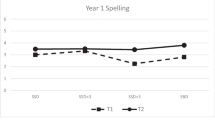Abstract
Results from a project conducted in Mexico are discussed, in which a group of 17 indigenous teachers analyzed the numeration systems of their first language. The main goal of the project is to develop resources that help teachers in supporting students’ understanding of the systems. In the first phase of the project, the central organizing ideas of 14 numeration systems were specified. Each system belonged to a different Mesoamerican language. Three aspects of the systems were identified that would have to be accounted for in instructional design. They include using 20 as a multiplicative base. Examples are presented of the instructional resources that indigenous teachers could use to help their students understand the quantitative rationales of the systems.












Similar content being viewed by others
Notes
Peru’s indigenous population of more than 8,000,000 is the biggest in the Americas.
Students for this program are recruited in regions throughout Mexico with a high presence of indigenous population.
I am grateful to Linguist Soledad Pérez for supporting the research team in using the International Phonetic Alphabet.
Of the 14 systems, Mazahua and Tarahumara use 10 as a multiplicative base. The others use 20.
Tsotsil is a Mayan language, closely related to Tseltal and Cho’l, whose numeration system also follows a vigesimal possessiveness rationale.
References
Barriga, F. (1998). Los sistemas de numeración indoamericanos (The Indo American numeration-systems). Mexico City: Universidad Nacional Autónoma de México.
Barriga, F. (2005). Historia natural de los sistemas de numeración (Natural history of numeration-systems). In M. Alvarado & B. M. Brizuela (Eds.), Haciendo números: Las notaciones numéricas vistas desde la psicología la didáctica y la historia (pp. 13–29). Mexico City: Paidós.
Carpenter, T. P., Blanton, M. L., Cobb, P., Franke, M. L., Kaput, J. J., & McClain, K. (2004). Scaling up innovative practices in mathematics and science. Madison: National Center for Improving Student Learning and Achievement in Mathematics and Science.
Cobb, P., Gravemeijer, K., Yackel, E., McClain, K., & Whitenack, J. (1997). Mathematizing and symbolizing: The emergence of chains of signification in one first-grade classroom. In D. Kirshner & J. A. Whitson (Eds.), Situated cognition: Social, semiotic, and psychological perspectives (pp. 151–232). Mahwah: Lawrence Erlbaum.
Cobb, P., Confrey, J., diSessa, A. A., Lehrer, R., & Schauble, L. (2003). Design experiments in education research. Educational Researcher, 32(1), 9–13.
Cobb, P., Zhao, Q., & Visnovska, J. (2008). Learning from and adapting the theory of realistic mathematics education. Education et Didactique, 2(1), 55–73.
D’Ambrosio, U. (2001). General remarks on ethnomathematics. ZDM, 33, 37–39.
Dirección General de Educación Indígena. (2010). Educación básica indígena (Indigenous elementary education). Mexico City: Secretaría de Educación Pública.
Ellerton, N. F., & Clarkson, P. C. (1996). Language factors in mathematics teaching. In A. J. Bishop (Ed.), International handbook of mathematics education (pp. 987–1033). Dordrecht: Kluwer.
Gravemeijer, K., Cobb, P., Bowers, J., & Whitenack, J. (2000). Symbolizing, modeling, and instructional design. In P. Cobb, E. Yackel, & K. McClain (Eds.), Symbolizing and communicating in mathematics classrooms: Perspectives on discourse, tools, and instructional design. Mahwah: Lawrence Erlbaum.
Greenberg, J. H. (1990). Generalizations about numeral systems. In K. Denning & S. Kemmer (Eds.), On languages: Selected writings of Joseph H. Greenberg (pp. 271–309). California: EEUU: Stanford University Press.
Harrison, K. D. (2007). When languages die. New York: Oxford University Press.
Instituto Nacional de Estadística y Geografía. (2011). Censo de población y vivienda 2010 (Population and housing census 2010). Mexico City: Instituto Nacional de Estadística y Geografía.
Instituto Nacional para la Evaluación de la Educación. (2009). Panorama educativo de México, 2009 (Statistical profile of Mexico’s education, 2009). Mexico City: Instituto Nacional para la Evaluación de la Educación.
International Phonetic Association. (1999). Handbook of the International Phonetic Association. New York: Cambridge University Press.
Nunes, T. (1996). What is the difference between one, un, and yi? In C. S. Mansfield, N. A. Pateman, & N. Bednarz (Eds.), Mathematics for tomorrow’s young children: International perspectives on curriculum (pp. 177–185). Dordrecht: Kluwer.
Nunes, T., & Bryant, P. (1996). Children doing mathematics. Malden: Blackwell.
Penuel, W. R., Roschelle, J., & Shechtman, N. (2007). Designing formative assessment software with teachers: an analysis of the co-design process. Research and Practice in Technology Enhanced Learning, 2, 51–74.
Sarama, J., & Clements, D. H. (2009). Early childhood mathematics education research. New York: Routledge.
Secretaría de Educación Pública. (2009). Plan de estudios 2009. Educación básica. Primaria (Program of studies 2009. Elementary education. Primary education). Mexico City: Secretaría de Educación Pública.
Secretaría de Educación Pública. (2011). Sistema educativo de los Estados Unidos Mexicanos, principales cifras, ciclo escolar 2009–2010 (Educational system of the Mexican United States, main data, school-year 2009–2010). Mexico City: Secretaría de Educación Pública.
Simon, M. A. (1995). Reconstructing mathematics pedagogy from a constructivist perspective. Journal for Research in Mathematics Education, 26, 114–145.
Wright, R. J., Martland, J., Stafford, A. K., & Stanger, G. (2006). Teaching number. Thousand Oaks: Paul Chapman.
Yamamoto, K. (2005). The acquisition of numeral classifiers: The case of Japanese children. Berlin: Mouton de Gruyter.
Acknowledgments
This paper was possible thanks to the work of the 17 indigenous teachers that participated in the research project. They are Adriana Roque Corona (Otomí), Belén Juárez López (Totonaco), Domingo Arcos Vázquez (Cho’l), Elodia Velasco Pacheco (Mixteco), Emma Candia Estrada (Tlapaneco), Flor Neyvis Hernández Mendoza (Chatino), Jorge Mendoza Cumplido (Southern Tepehuano), Judith Ibarra Bruno (Tlapaneco), Minerva Merino López (Mixteco), Nancy Martínez Ramírez (Náhuatl), Norma Filomena Martínez Jiménez (Mixe), Odelba Villegas López (Tarahumara), Reyna Isabel Santiz Gómez (Tseltal), Rogelio Ruiz Carrizosa (Mazateco), Silvia Benito Méndez (Mazahua), Vicente Hernández López (Triqui), and Yolanda Hernández Aguilar (Náhuatl). I am grateful to all of them. I am also grateful to the Universidad Pedagógica Nacional (Mexico’s National Pedagogical University) for funding the project.
Author information
Authors and Affiliations
Corresponding author
Rights and permissions
About this article
Cite this article
Cortina, J.L. Supporting indigenous students’ understanding of the numeration system of their first language. Math Ed Res J 25, 23–42 (2013). https://doi.org/10.1007/s13394-012-0043-6
Received:
Revised:
Accepted:
Published:
Issue Date:
DOI: https://doi.org/10.1007/s13394-012-0043-6




